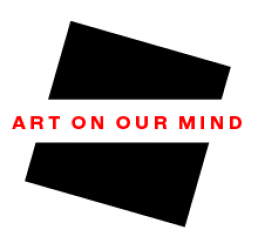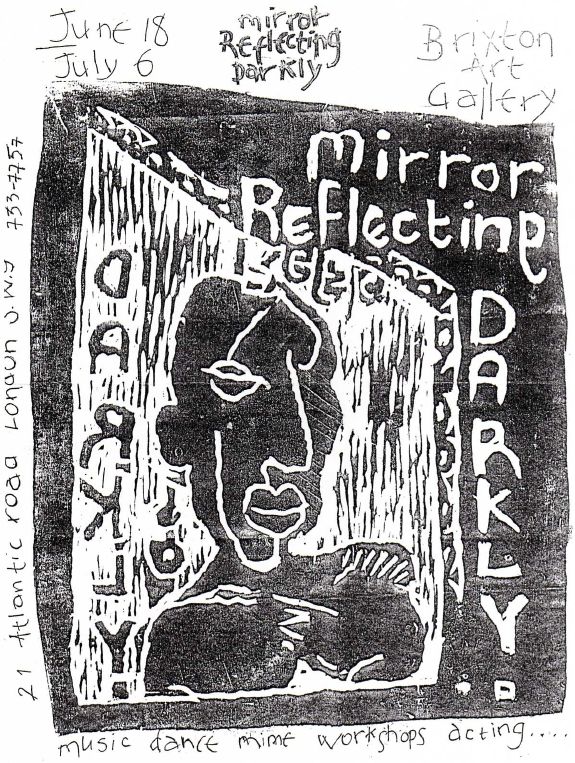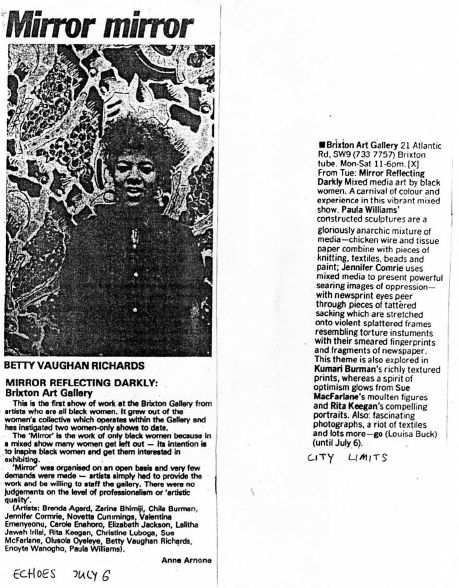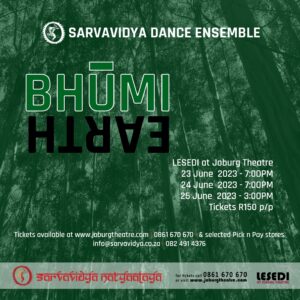Art catalogues, books and journal articles featuring works by Lallitha Jawahirilal
Chambers, E. (2014) Black Artists in British Art: A History since the 1950s. London: Bloomsbury Publishing.
Google Books preview here
Cooney, L. (ed.) (2011) South Africa: Artists, Prints, Community: Twenty-Five Years at the Caversham Press. Boston: Boston University. Exhibition Catalogue, p. 70.
[download pdf here]
Brzyski, A. (ed.) (2007) Partisan Canons. Durham: Duke University Press.
Google Books preview here
Marschall, S. (2004) Serving Male Agendas: Two National Women’s Monuments in South Africa, Women’s Studies, 33:8, 1009-1033,
DOI: 10.1080/00497870490890816
Pissarra, M. (2004) The Luggage is Still Labelled, Third Text, 18:2, 183-191
DOI: 10.1080/0952882032000199696
Vale, P., Ruiters, G. (2004) The Right Way Up? South Africa Ten Years On. International Politics, 41, 375–393 (2004).
https://doi.org/10.1057/palgrave.ip.8800083
Khan, S. (2004) Lallitha Jawahirilal. In: Khan, S. (ed.) The ID of South African artists. Amsterdam : Stichting Art & Theatre, 134-137.
[download pdf here]
Deliry-Antheaume, E. (2003) Readings from the walls: art and education. Perspectives in Education, 21:2, 1 – 14.
https://hdl.handle.net/10520/EJC87202
Marschall, S. (2001) The Poetics of Politics. Imagi[ni]ng the New South African Nation. Safundi, 2:2, 1-20, doi: 10.1080/17533170100102201
Deliry-Antheaume, E. (2000) Murs des écoles, école des murs en Afrique du Sud. Les institutions éducatives vues du dehors. In: Lange, M.F. (ed.) Des écoles pour le Sud. Aube: IRD Editions, 167-175.
[download pdf here]
Abstract (english)
School walls, the school of walls in South Africa : how education institutions are seen from the outside
School walls reflect local architectural story in educational establishments. Graffiti and mural art witness to the recent transformations in South African society and often draw attention to the right to education and to the environ- ment in which education is offered. By review- ing a number of creative experiments (with photos), we see that the walls are themselves transformed into « schools » and provide an alternative form of teaching which can contri- bute to the healing as well as the reconstruc- tion of a society undermined by decades of segregation.
Bedford, E. et al. (eds.) (1997) Contemporary South African Art 1985 – 1995 from the South African National Gallery Permanent Collection. Cape Town: South African National Gallery.
Delfina Studio Trust (1990) Annual Group Show at Delfina Studios. London: Delfina.
Sebestyen, A (1990) Lallitha Jawahirilal, City Limits, 6-13 December 1990, 24
Oliphant, A. W. (1989) The art of Lallitha Jawahirilal. Staffrider8:2 (1989), 48-53
[download pdf here]
Academic theses mentioning works by Lallitha Jawahirilal
Lilla, Q. (2018) Setting Art Apart: Inside and Outside the South African National Gallery (1895-2016). PhD Thesis, Stellenbosch University, https://scholar.sun.ac.za/handle/10019.1/103265.
[download pdf here]
Adendorff, D. A. (2017) The Princess in the Veld: Curating Liminality in Contemporary South African Female Art Production. PhD Thesis, University of Pretoria.
http://hdl.handle.net/2263/63007
Pillay, T. (2014) The artistic practices of contemporary South African Indian women artists : how race, class and gender affect the making of visual art. MA Thesis, Unisa, http://uir.unisa.ac.za/handle/10500/18736
[download pdf here]
Malatjie, L. P. (2012) Framing the artwork of Tracey Rose and Berni Searle through black feminism. MA Thesis University of the Witwatersrand
http://hdl.handle.net/10539/11750
[download pdf here]
Moodley, N. (2012) Culture, politics and identity in the visual art of Indian South African graduates from the University of Durban-Westville in KwaZulu-Natal, 1962-1999. PhD Thesis, UKZN, https://researchspace.ukzn.ac.za/handle/10413/10724
[download pdf here]
Khan, S. (2006) A critical analysis of the iconography of six HIV/AIDS murals from Johannesburg and Durban, in terms of race, class and gender. MA Thesis University of the Witwatersrand, http://wiredspace.wits.ac.za/handle/10539/4694
[download pdf here]
Burger, M. A. C. (2005) Transformation within personal and public realms through contemporary artmaking processes. MA Thesis, University of Johannesburg
http://hdl.handle.net/10210/5247
[dowlnload pdf here]
White, E. 2004. There’s no place (like home) : a graphic interpretation of personal notions of home and displacement. MA Thesis, Unisa, University of Cape Town
http://hdl.handle.net/11427/10891
[download pdf here]
Khan, S. (2002) A critical analysis of the depiction of women in murals in Kwazulu-Natal. Thesis in partial fulfilment of MA (Fine Arts), University of Durban-Westville. Supervisor: Sabine Marschall). [download pdf here]









